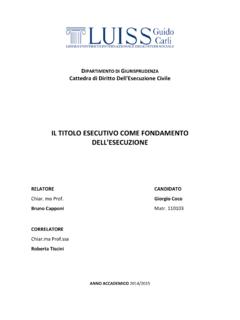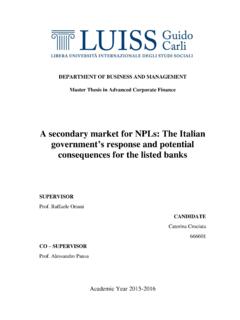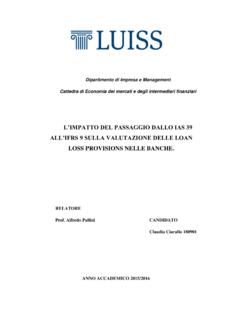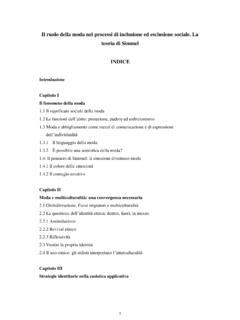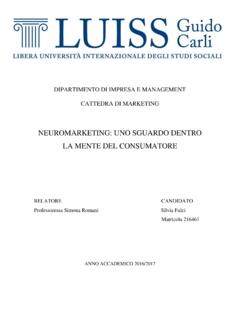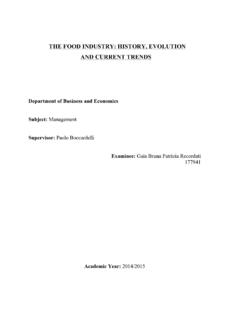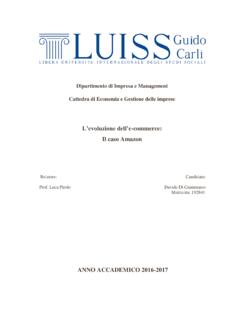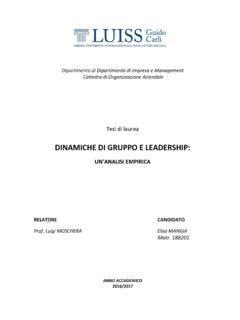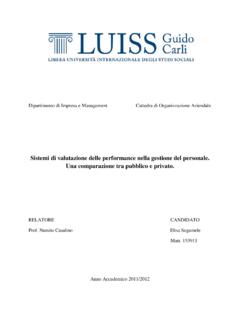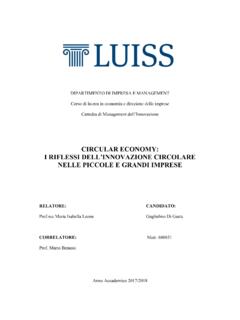Transcription of TESLA MOTORS: A BUSINESS MODEL INNOVATION IN THE ...
1 Dipartimento di IMPRESA E MANAGEMENT. Cattedra STRATEGIE D'IMPRESA. TESLA MOTORS: A BUSINESS . MODEL INNOVATION IN THE. AUTOMOTIVE INDUSTRY. RELATORE. Prof. Paolo BOCCARDELLI. CANDIDATO. Andrea MONSELLATO. Matricola 659181. CORRELATORE. Prof. Enzo PERUFFO. ANNO ACCADEMICO 2014/2015. Index Chapter I The gasoline alternatives and the market analysis Introduction .. 4. The oil industry .. 6. Diesel .. 10. Diesel gate .. 13. Biodiesel .. 14. Bioethanol .. 16. Natural gas .. 16. Hybrids .. 17. Electric Vehicles (EVs) .. 18. Fuel cell (Hydrogen).
2 19. The mass electrification of the industry and the partnerships inside the sector .. 20. Industry analysis and carmakers' strategies .. 24. BMW Group .. 32. Audi .. 35. Mercedes .. 37. Volvo .. 38. General Motors (Cadillac).. 40. Jaguar Land Rover .. 41. Toyota (Lexus) .. 43. Nissan (Infiniti) .. 44. Chapter II - The BUSINESS MODEL BUSINESS MODEL definition and literature .. 46. BUSINESS MODEL INNOVATION .. 58. BUSINESS MODEL and strategy .. 63. The Osterwalder & Pigneur approach to the BUSINESS MODEL and the BUSINESS MODEL Canvas.
3 70. The Osterwalder & Pigneur approach to the BUSINESS MODEL : its classification, and design .. 70. The BUSINESS MODEL Canvas: its depiction, features and 73. Chapter III - TESLA Motors and the study of its BUSINESS MODEL TESLA Motors: history, models and results.. 84. Other TESLA products: TESLA Powerwall, TESLA Supercharger and the all new TESLA Gigafactory .. 94. Elon Musk: the man behind TESLA Motors and many other successful ideas.. 96. TESLA Motors' supply chain strategy .. 98. TESLA 's BUSINESS MODEL study and BUSINESS MODEL 101.
4 Introduction .. 101. TESLA 's BUSINESS MODEL analysis using the BUSINESS MODEL Canvas .. 102. Key Partners block .. 102. Key Activities block .. 104. Key Resources block .. 105. Cost Structure block .. 107. Revenue Streams block .. 109. Value Proposition block .. 110. Customer Relationships block .. 112. Channels block .. 113. Customer Segments block .. 115. TESLA 's BUSINESS MODEL INNOVATION in the automotive 116. Discussion .. 119. Future trends in the automotive industry .. 122. Conclusions .. 125. Reference list .. 128. Websites .. 133.
5 Chapter I - The gasoline alternatives and the market analysis Introduction The automotive industry has seen some big changes in the last few decades. The advent of new sources has always been related to the need in finding new solutions, especially in periods in which the oil price was increasing, or new techniques or technologies were found to innovate how people get around. Lots of innovations that we can find in modern vehicles came directly from 19th century, but these were either used just for small lots of cars or dismissed ones, because the gasoline engine proved to be better with regard to building simplicity the very first INNOVATION in building processes were made by Ford and Taylor at mid-1910s , maintenance, affordability, reliability, cost and ease of use.
6 The 2008-2010 crisis which weakened the entire sector, has led to substantial consequences. The main reason of this crisis was the increase of the automotive fuel price, directly connected to the slow growth of the SUVs or pickup trucks, models which were very profitable for the Big Three (Ford, General Motors and Chrysler, the three most important American carmakers), but not so fuel efficient. The offer of fuel efficient vehicles was scarce and this led to the fall of the sales which, combined to the credit crunch which put pressure on raw material prices, convicted customers to demand more compact, fuel efficient vehicles, typically imported from Asia or Europe.
7 The Big Three offers big tag price discount all over the country and new marketing campaigns which resulted unable to slow the drain in sales and margins. In 2014, a Mediobanca study showed how the sector is now in good health, being the third most profitable industry after the energy BUSINESS and the electronic one, with Japan and Germany-based companies at the top1. The recovery may be ascribed to the deep changes involving the sector, the development of new sources and strategies to be less oil dependent and the improved safety standards to protect both the inside passengers and the outside people.
8 The main tendencies in the industry are: - the development of small engines, turbo charged, with better fuel efficiency which emit less pollution. To do that, the engines are smaller, with less cylinders and are lighter (downsizing), they use technologies to reduce emissions like Stop and Start or Active Fuel Management technology. The designs are more complex to improve the aerodynamics and to reduce the drag coefficient;. - new studies on materials are financed to find the right ones to be both more eco-friendly, more resistant and to weigh less, by using new alloys and fibers.
9 - to improve safety, new cars are more and more connected to the internet to inform drivers about weather conditions and road traffic. They use very complex infotainment systems that control pretty much of each car's 1 nuova-edizione-dell-indagine-sulle-multi nazionali-2003-2013-con-un-focus-sull- settings. Many carmakers are improving some infrastructures to aid the communication between different vehicles, with benefits on the safety and the driving comfort;. - technology helps to prevent car collisions and to improve the automatic driving system, by adopting all around radars and sensors that can brake and accelerate autonomously.
10 They can send as well automatic SOS messages in case of emergency by using GPS location;. - performance improvements, by taking many technologies out of the auto racing industry. In the following paragraphs, I will enlist many of the possible alternative sources to gasoline, by showing a brief history, how they work, strengths and weaknesses of every source and some information related to them, after a brief introduction about the industry itself and its latest implications. Then I will speak about the industry itself: the main players, their histories, their strategies, their numbers and their future perspectives.
